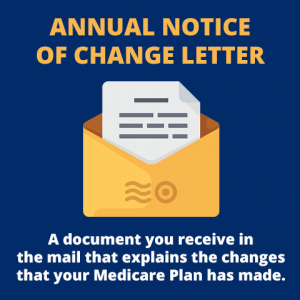- Who Will Receive the Medicare ANOC Letter?
- What is Medicare Annual Notice of Change?
- Changes to Medicare Plans You Can Anticipate
- When Will the Provider Send Your ANOC Medicare Letter?
- Where Will the Plan Providers Mail Your ANOC?
- Evidence of Coverage (EOC)
- What if I Don’t Like the Changes Listed in My ANOC?
- How To Decide if You Want Different Medicare Coverage for Your Needs
Medicare plan costs and benefits change each year. Understanding those changes is essential to ensuring you continue to get the Medicare coverage you need. Your Medicare Annual Notice of Change allows you to be aware of these annual changes to your health insurance so that you can be prepared for them when they go into effect the following year.
Who Will Receive the Medicare ANOC Letter?
You can expect to receive a Medicare Annual Notice of Change letter if you are a beneficiary with Medicare Advantage or a Medicare Part D prescription drug plan.
However, you should not expect to receive an Annual Notice of Change for a Medicare Supplement plan. That is because Medicare Supplement (Medigap) Plans do not incur annual changes to benefits. So, the letter is not necessary.
What is Medicare Annual Notice of Change?
The Medicare Annual Notice of Change letter is something you receive every year from your Medicare Advantage plan or Medicare Part D plan. The ANOC provides all of the information you need on any changes to your plan’s cost and coverage that will take place on January 1 st of the following year.
It’s a good idea to thoroughly review your Annual Notice of Change Medicare updates to see if your current plan will still meet your healthcare needs and budget in the new year.
You should contact your plan’s insurance company if you do not receive your ANOC.
Changes to Medicare Plans You Can You Anticipate
The ANOC letter will include any changes to your Medicare Advantage or Medicare Part D plan. It will outline cost changes and, if applicable, benefit and service area changes.
Find Medicare Plans in 3 Easy Steps
Let us help you navigate your Medicare journey
Those on Medicare Advantage will receive a letter from their private insurance company providing their coverage. The correspondence will include changes in costs, benefits, and any adjustments to the service area.
Private insurers offering Medicare Part D plans must also send their beneficiaries an ANOC letter. For Medicare Part D prescription drug plans, the ANOC will outline any cost, service area, and formulary changes.
It is crucial to note any Medicare Part D formulary changes involving medications you’re prescribed. You could have much higher copays if a drug no longer receives coverage or changes tiers.
When Will the Provider Send Your Medicare Annual Notice of Change Letter?
Medicare guidelines require carriers to send the ANOC annually in the fall. You should anticipate receiving your letter(s) in September.
If you do not receive a letter for each of your Medicare plans by September 30, you should contact the plan provider. Any changes take effect January 1 st of the following year.
Where Will the Plan Providers Mail Your ANOC?
Your insurance carrier will send your Annual Notice of Change to the address you have on file with them.
Without your current address on file, you will not receive the ANOC that Medicare sends out each fall. You must also ensure your address is up-to-date with any private insurance companies with whom you do business. Otherwise, you will not receive the ANOC in the mail each autumn.
Evidence of Coverage (EOC)
You will also receive your Evidence of Coverage (EOC) notice in September. This is different from your Annual Notice of Change. While your ANOC focuses on cost and coverage changes, your EOC is more comprehensive. The EOC goes into detail about your plan’s benefits, cost-sharing expenses, how your plan works, and exactly what your plan covers. You should carefully review both documents to see if your Medicare plan will still suit your needs for next year.
Find Medicare Plans in 3 Easy Steps
Let us help you navigate your Medicare journey
What if I Don’t Like the Changes Listed in My ANOC?

If you don’t like the upcoming changes to your Medicare plan in your ANOC, you can always switch plans. The reason you receive your Annual Notice of Change in September is so you know if you want to go with different coverage in time for the Annual Enrollment Period (AEP).
The Medicare Annual Enrollment Period is from October 15 until December 7 each year. With the list of changes, the ANOC provides, you can contact your insurance agent to review options that may be a better fit for the next calendar year.
The Centers for Medicare & Medicaid Services (CMS) determines Medicare Part A and Part B plan benefits and costs. Therefore, these figures are non-negotiable. Original Medicare beneficiaries receive the Annual Notice of Change letter only as a notification.
How To Decide if You Want Different Medicare Coverage for Your Needs
Step 1: After receiving your Annual Notice of Change letter, you should contact your licensed agent to review the policy changes. A benefit comparison should include a list of the services you most frequently utilize.
Step 2: If you have a Medicare Advantage plan, you may encounter changes to your doctor network. If you want to keep your doctors in the upcoming year, you might want to switch to a Medigap plan that could include your preferred providers. It is also possible that your health needs have changed since last year, and you need more coverage than you initially thought.
Step 3: Lastly, consider your premium costs and expected cost-sharing. Review the service area in which your current plan is available and compare it to any potential service area changes you can expect for the following year.
- Was this article helpful ?
- Yes (8)No